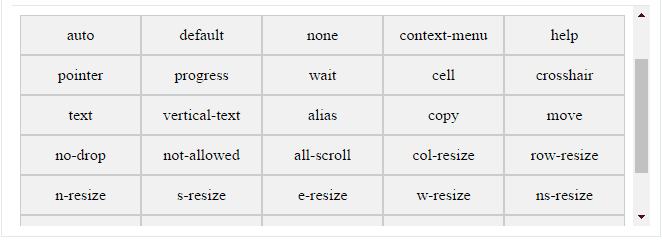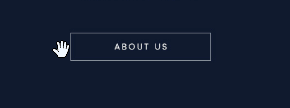How to change the cursor into a hand when a user hovers over a list item?
I've got a list, and I have a click handler for its items:
<ul>
<li>foo</li>
<li>goo</li>
</ul>
How can I change the mouse pointer into a hand po开发者_StackOverflowinter (like when hovering over a button)? Right now the pointer turns into a text selection pointer when I hover over the list items.
In light of the passage of time, as people have mentioned, you can now safely just use:
li { cursor: pointer; }
Use for li:
li:hover {
cursor: pointer;
}
See more cursor properties with examples after running snippet option:

.auto { cursor: auto; }
.default { cursor: default; }
.none { cursor: none; }
.context-menu { cursor: context-menu; }
.help { cursor: help; }
.pointer { cursor: pointer; }
.progress { cursor: progress; }
.wait { cursor: wait; }
.cell { cursor: cell; }
.crosshair { cursor: crosshair; }
.text { cursor: text; }
.vertical-text { cursor: vertical-text; }
.alias { cursor: alias; }
.copy { cursor: copy; }
.move { cursor: move; }
.no-drop { cursor: no-drop; }
.not-allowed { cursor: not-allowed; }
.all-scroll { cursor: all-scroll; }
.col-resize { cursor: col-resize; }
.row-resize { cursor: row-resize; }
.n-resize { cursor: n-resize; }
.e-resize { cursor: e-resize; }
.s-resize { cursor: s-resize; }
.w-resize { cursor: w-resize; }
.ns-resize { cursor: ns-resize; }
.ew-resize { cursor: ew-resize; }
.ne-resize { cursor: ne-resize; }
.nw-resize { cursor: nw-resize; }
.se-resize { cursor: se-resize; }
.sw-resize { cursor: sw-resize; }
.nesw-resize { cursor: nesw-resize; }
.nwse-resize { cursor: nwse-resize; }
.cursors > div {
float: left;
box-sizing: border-box;
background: #f2f2f2;
border:1px solid #ccc;
width: 20%;
padding: 10px 2px;
text-align: center;
white-space: nowrap;
&:nth-child(even) {
background: #eee;
}
&:hover {
opacity: 0.25
}
}<h1>Example of cursor</h1>
<div class="cursors">
<div class="auto">auto</div>
<div class="default">default</div>
<div class="none">none</div>
<div class="context-menu">context-menu</div>
<div class="help">help</div>
<div class="pointer">pointer</div>
<div class="progress">progress</div>
<div class="wait">wait</div>
<div class="cell">cell</div>
<div class="crosshair">crosshair</div>
<div class="text">text</div>
<div class="vertical-text">vertical-text</div>
<div class="alias">alias</div>
<div class="copy">copy</div>
<div class="move">move</div>
<div class="no-drop">no-drop</div>
<div class="not-allowed">not-allowed</div>
<div class="all-scroll">all-scroll</div>
<div class="col-resize">col-resize</div>
<div class="row-resize">row-resize</div>
<div class="n-resize">n-resize</div>
<div class="s-resize">s-resize</div>
<div class="e-resize">e-resize</div>
<div class="w-resize">w-resize</div>
<div class="ns-resize">ns-resize</div>
<div class="ew-resize">ew-resize</div>
<div class="ne-resize">ne-resize</div>
<div class="nw-resize">nw-resize</div>
<div class="se-resize">se-resize</div>
<div class="sw-resize">sw-resize</div>
<div class="nesw-resize">nesw-resize</div>
<div class="nwse-resize">nwse-resize</div>
</div>You do not require jQuery for this, simply use the following CSS content:
li {cursor: pointer}
And voilà! Handy.
Use:
li:hover {
cursor: pointer;
}
Other valid values (which hand is not) for the current HTML specification can be viewed here.
Use
cursor: pointer;
cursor: hand;
if you want to have a crossbrowser result!
CSS:
.auto { cursor: auto; }
.default { cursor: default; }
.none { cursor: none; }
.context-menu { cursor: context-menu; }
.help { cursor: help; }
.pointer { cursor: pointer; }
.progress { cursor: progress; }
.wait { cursor: wait; }
.cell { cursor: cell; }
.crosshair { cursor: crosshair; }
.text { cursor: text; }
.vertical-text { cursor: vertical-text; }
.alias { cursor: alias; }
.copy { cursor: copy; }
.move { cursor: move; }
.no-drop { cursor: no-drop; }
.not-allowed { cursor: not-allowed; }
.all-scroll { cursor: all-scroll; }
.col-resize { cursor: col-resize; }
.row-resize { cursor: row-resize; }
.n-resize { cursor: n-resize; }
.e-resize { cursor: e-resize; }
.s-resize { cursor: s-resize; }
.w-resize { cursor: w-resize; }
.ns-resize { cursor: ns-resize; }
.ew-resize { cursor: ew-resize; }
.ne-resize { cursor: ne-resize; }
.nw-resize { cursor: nw-resize; }
.se-resize { cursor: se-resize; }
.sw-resize { cursor: sw-resize; }
.nesw-resize { cursor: nesw-resize; }
.nwse-resize { cursor: nwse-resize; }
You can also have the cursor be an image:
.img-cur {
cursor: url(images/cursor.png), auto;
}
I think it would be smart to only show the hand/pointer cursor when JavaScript is available. So people will not have the feeling they can click on something that is not clickable.
To achieve that you could use the JavaScript libary jQuery to add the CSS to the element like so
$("li").css({"cursor":"pointer"});
Or chain it directly to the click handler.
Or when modernizer in combination with <html class="no-js"> is used, the CSS would look like this:
.js li { cursor: pointer; }
li:hover {cursor: hand; cursor: pointer;}
Just for completeness:
cursor: -webkit-grab;
It also gives a hand, the one you know when moving the view of an image around.
It is quite useful if you want to emulate grab behavior using jQuery and mousedown.

For complete cross browser, use:
cursor: pointer;
cursor: hand;
You can change it either on hover or just specify cursor:pointer on list item, both will work.
ul li {
cursor: pointer;
}
Alternatively
ul li:hover {
cursor: pointer;
}
For being able to make anything get the "mousechange" treatment, you can add a CSS class:
.mousechange:hover {
cursor: pointer;
}<span class="mousechange">Some text here</span>I would not say to use cursor:hand since it was only valid for Internet Explorer 5.5 and below, and Internet Explorer 6 came with Windows XP (2002). People will only get the hint to upgrade when their browser stops working for them. Additionally, in Visual Studio, it will red underline that entry. It tells me:
Validation (CSS 3.0): "hand" is not a valid value for the "cursor" property
Simply just do something like this:
li {
cursor: pointer;
}
I apply it on your code to see how it works:
li {
cursor: pointer;
}<ul>
<li>foo</li>
<li>goo</li>
</ul>Note: Also DO not forget you can have any hand cursor with customised cursor, you can create fav hand icon like this one for example:
div {
display: block;
width: 400px;
height: 400px;
background: red;
cursor: url(http://findicons.com/files/icons/1840/free_style/128/hand.png) 4 12, auto;
}<div>
</div>ul li:hover{
cursor: pointer;
}
Simply put this code.
li{cursor: pointer;}
All of the other responses suggest using the standard CSS pointer, however, there are two methods:
Apply the CSS property
cursor:pointer;to the elements. (This is the default style when a cursor hovers over a button.)Apply the CSS property
cursor:url(pointer.png);using a custom graphic for your pointer. This may be more desirable if you want to ensure that the user experience is identical on all platforms (instead of allowing the browser/OS decide what your pointer cursor should look like). Note that fallback options may be added in case the image is not found, including secondary urls or any of the other options i.e.cursor:url(pointer.png,fallback.png,pointer);
Of course these may be applied to the list items in this manner li{cursor:pointer;}, as a class .class{cursor:pointer;}, or as a value for the style attribute of each element style="cursor:pointer;".
Use:
ul li:hover{
cursor: pointer;
}
For more mouse events, check CSS cursor property.
You can use one of the following:
li:hover
{
cursor: pointer;
}
or
li
{
cursor: pointer;
}
Working example 1:
li:hover
{
cursor: pointer;
}<ul>
<li>foo</li>
<li>bar</li>
</ul>Working example 2:
li
{
cursor: pointer;
}<ul>
<li>foo</li>
<li>bar</li>
</ul>For a basic hand symbol:
Try
cursor: pointer
If you want a hand symbol like drag some item and drop it, try:
cursor: grab
You can use the code below:
li:hover { cursor: pointer; }
Using an HTML Hack
Note: this is not recommended as it is considered bad practice
Wrapping the content in an anchor tag containing an href attribute will work without explicitly applying the cursor: pointer; property with the side effect of anchor properties (amended with CSS):
<a href="#" style="text-decoration: initial; color: initial;"><div>This is bad practice, but it works.</div></a>You can also use the following style:
li {
cursor: grabbing;
}
Check the following. I get it from W3Schools.
.alias { cursor: alias; }
.all-scroll { cursor: all-scroll; }
.auto { cursor: auto; }
.cell { cursor: cell; }
.context-menu { cursor: context-menu; }
.col-resize { cursor: col-resize; }
.copy { cursor: copy; }
.crosshair { cursor: crosshair; }
.default { cursor: default; }
.e-resize { cursor: e-resize; }
.ew-resize { cursor: ew-resize; }
.grab {
cursor: -webkit-grab;
cursor: grab;
}
.grabbing {
cursor: -webkit-grabbing;
cursor: grabbing;
}
.help { cursor: help; }
.move { cursor: move; }
.n-resize { cursor: n-resize; }
.ne-resize { cursor: ne-resize; }
.nesw-resize { cursor: nesw-resize; }
.ns-resize { cursor: ns-resize; }
.nw-resize { cursor: nw-resize; }
.nwse-resize { cursor: nwse-resize; }
.no-drop { cursor: no-drop; }
.none { cursor: none; }
.not-allowed { cursor: not-allowed; }
.pointer { cursor: pointer; }
.progress { cursor: progress; }
.row-resize { cursor: row-resize; }
.s-resize { cursor: s-resize; }
.se-resize { cursor: se-resize; }
.sw-resize { cursor: sw-resize; }
.text { cursor: text; }
.url { cursor: url(myBall.cur), auto; }
.w-resize { cursor: w-resize; }
.wait { cursor: wait; }
.zoom-in { cursor: zoom-in; }
.zoom-out { cursor: zoom-out; }<!DOCTYPE html>
<html>
<body>
<h1>The cursor property</h1>
<p>Mouse over the words to change the mouse cursor.</p>
<p class="alias">alias</p>
<p class="all-scroll">all-scroll</p>
<p class="auto">auto</p>
<p class="cell">cell</p>
<p class="context-menu">context-menu</p>
<p class="col-resize">col-resize</p>
<p class="copy">copy</p>
<p class="crosshair">crosshair</p>
<p class="default">default</p>
<p class="e-resize">e-resize</p>
<p class="ew-resize">ew-resize</p>
<p class="grab">grab</p>
<p class="grabbing">grabbing</p>
<p class="help">help</p>
<p class="move">move</p>
<p class="n-resize">n-resize</p>
<p class="ne-resize">ne-resize</p>
<p class="nesw-resize">nesw-resize</p>
<p class="ns-resize">ns-resize</p>
<p class="nw-resize">nw-resize</p>
<p class="nwse-resize">nwse-resize</p>
<p class="no-drop">no-drop</p>
<p class="none">none</p>
<p class="not-allowed">not-allowed</p>
<p class="pointer">pointer</p>
<p class="progress">progress</p>
<p class="row-resize">row-resize</p>
<p class="s-resize">s-resize</p>
<p class="se-resize">se-resize</p>
<p class="sw-resize">sw-resize</p>
<p class="text">text</p>
<p class="url">url</p>
<p class="w-resize">w-resize</p>
<p class="wait">wait</p>
<p class="zoom-in">zoom-in</p>
<p class="zoom-out">zoom-out</p>
</body>
</html>just using CSS to set customize the cursor pointer
/* Keyword value */
cursor: pointer;
cursor: auto;
/* URL, with a keyword fallback */
cursor: url(hand.cur), pointer;
/* URL and coordinates, with a keyword fallback */
cursor: url(cursor1.png) 4 12, auto;
cursor: url(cursor2.png) 2 2, pointer;
/* Global values */
cursor: inherit;
cursor: initial;
cursor: unset;
/* 2 URLs and coordinates, with a keyword fallback */
cursor: url(one.svg) 2 2, url(two.svg) 5 5, progress;
demo
Note: cursor support for many format icons!
such as .cur, .png, .svg, .jpeg, .webp, and so on
li:hover{
cursor: url("https://cdn.xgqfrms.xyz/cursor/mouse.cur"), pointer;
color: #0f0;
background: #000;
}
/*
li:hover{
cursor: url("../icons/hand.cur"), pointer;
}
*/
li{
height: 30px;
width: 100px;
background: #ccc;
color: #fff;
margin: 10px;
text-align: center;
list-style: none;
}<ul>
<li>a</li>
<li>b</li>
<li>c</li>
</ul>refs
https://developer.mozilla.org/en-US/docs/Web/CSS/cursor
<style>
.para{
color: black;
}
.para:hover{
cursor: pointer;
color: blue;
}
</style>
<div class="para">
In the above HTML code [:hover] is used to indicate that the following style must be applied only on hovering or keeping the mouse cursor on it.
There are several types of cursors available in CSS:
View the below code for types of cursor:
<style>
.alias {cursor: alias;}
.all-scroll {cursor: all-scroll;}
.auto {cursor: auto;}
.cell {cursor: cell;}
.context-menu {cursor: context-menu;}
.col-resize {cursor: col-resize;}
.copy {cursor: copy;}
.crosshair {cursor: crosshair;}
.default {cursor: default;}
.e-resize {cursor: e-resize;}
.ew-resize {cursor: ew-resize;}
.grab {cursor: -webkit-grab; cursor: grab;}
.grabbing {cursor: -webkit-grabbing; cursor: grabbing;}
.help {cursor: help;}
.move {cursor: move;}
.n-resize {cursor: n-resize;}
.ne-resize {cursor: ne-resize;}
.nesw-resize {cursor: nesw-resize;}
.ns-resize {cursor: ns-resize;}
.nw-resize {cursor: nw-resize;}
.nwse-resize {cursor: nwse-resize;}
.no-drop {cursor: no-drop;}
.none {cursor: none;}
.not-allowed {cursor: not-allowed;}
.pointer {cursor: pointer;}
.progress {cursor: progress;}
.row-resize {cursor: row-resize;}
.s-resize {cursor: s-resize;}
.se-resize {cursor: se-resize;}
.sw-resize {cursor: sw-resize;}
.text {cursor: text;}
.url {cursor: url(myBall.cur),auto;}
.w-resize {cursor: w-resize;}
.wait {cursor: wait;}
.zoom-in {cursor: zoom-in;}
.zoom-out {cursor: zoom-out;}
</style>
Click the below link for viewing how the cursor property acts:
https://www.w3schools.com/cssref/tryit.asp?filename=trycss_cursor
 加载中,请稍侯......
加载中,请稍侯......
精彩评论